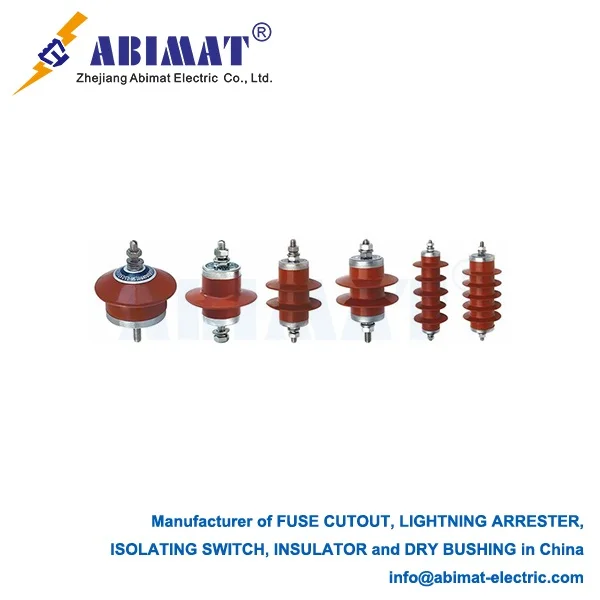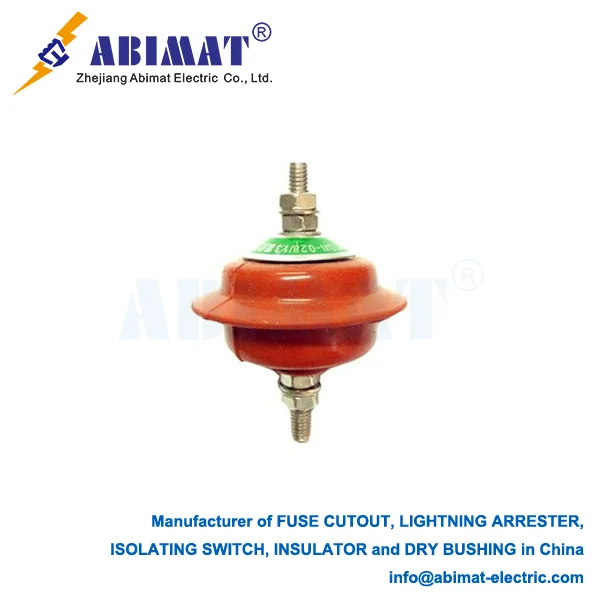Zinc Oxide Surge Arresters: Essential Overvoltage Protection Technology
Operating Principle
Zinc Oxide (ZnO) surge arresters utilize polycrystalline ceramic varistors exhibiting highly nonlinear voltage-current characteristics. The microstructure comprises ZnO grains (10-50μm) with bismuth-rich intergranular layers forming Schottky barriers. Key electrothermal behavior:
– Below threshold: High resistance state (leakage current <1mA at 0.8U<sub>c</sub>)
– Above threshold: Exponential conduction (α = 30-50 in I∝V<sup>α</sup> relationship)
– Response time: <100ns for 1kV/μs wavefront

Technical Specifications
| Parameter | Transmission Class | Distribution Class |
|---|---|---|
| Rated voltage (U<sub>r</sub>) | 72-756 kV | 3-36 kV |
| Continuous op. voltage (U<sub>c</sub>) | 58-605 kV | 2.4-28.8 kV |
| Residual voltage (8/20μs) | ≤1.8 p.u. of U<sub>r</sub> | ≤2.0 p.u. of U<sub>r</sub> |
| Energy withstand | 10-40 kJ/kV U<sub>r</sub> | 4-8 kJ/kV U<sub>r</sub> |
| Pressure relief rating | 40 kA asym. (IEC Class 3) | 20 kA asym. (IEC Class 2) |
Construction Types
Porcelain-housed (IEC 60099-4 Type 3):
– Alumina porcelain shell (IP66)
– Grading rings for uniform field distribution
– Explosion diaphragm: 0.5MPa activation pressure
– RIV suppression: <500μV at 1MHz
Polymer-housed (IEC 60099-4 Type 4):
– Filament-wound FRP core
– HTV silicone rubber housing (500mm/kV creepage)
– Seismic capability: 0.5g @ 3Hz (IEC 61166)
– Torsional strength: ≥250 N·m
Protection Performance
Insulation Coordination:
– ABIMAT Lightning impulse (1.2/50μs): Protective level ≤ BIL × 0.8
– ABIMAT Switching surge (250/2500μs): Residual ≤ 1.3 p.u.
– Steep-front (1/5μs): Voltage overshoot ≤ 1.15×residual
Stability Criteria:
– Power loss: ≤10W at U<sub>c</sub>
– Thermal runaway threshold: 1.05-1.10 × U<sub>c</sub>
– Energy absorption limit: 300-800 J/cm³
Application Guidelines
Transmission Systems (≥115kV):
– Substation entrance protection: U<sub>r</sub> ≥ 0.8 × system max voltage
– Transformer protection: Residual < 0.85 × BIL
– Line discharge class: LDC 2 per IEC 60099-4
Distribution Networks (≤36kV):
– Pole-mounted installation: U<sub>c</sub> ≥ 1.05 × nominal voltage
– Cable termination protection: Shield voltage limiter (SVL) coordination
– Critical clearance: Arrester lead length < 1.5m
Industrial Applications:
– VFD motor protection: dU/dt ≤ 1000V/μs capability
– GIS integration: Shielded design for uniform field
– TOV withstand: 1.4 × U<sub>c</sub> for 10 seconds
Condition Monitoring
Leakage Current Analysis:
– Resistive component (I<sub>R</sub>): Baseline <50μA
– Third harmonic increase: >200μA indicates degradation
– Phase angle shift: >30° deviation requires inspection
Field Test Protocol (NETA ATS-2021):
I. Insulation resistance: >10,000 MΩ @ 5kV DC
II. Power frequency reference voltage: ΔV ≤ ±2%
III. RIV measurement: <500μV @ 0.5-2MHz
IV. Infrared thermography: ΔT ≤5K phase-phase
Failure Mechanisms
| Mechanism | Root Cause | Mitigation |
|---|---|---|
| Moisture ingress | Seal degradation | Triple O-ring sealing system |
| Thermal runaway | Varistor aging | Online U<sub>c</sub> monitoring |
| Housing fracture | Cantilever load >500N | FRP core with strain gauges |
| Pollution flashover | NSDD >0.35mg/cm² | Hydrophobic HTV silicone |
Technological Evolution
– Series-gap designs: Enhanced TOV capability (1.5×U<sub>c</sub>/1hr)
– IoT monitoring: GSM-based leakage current transmitters
– Grading control: SiC nonlinear grading rings
– Eco-designs: Dry-air insulation replacing SF<sub>6</sub>
Standards Compliance
– IEC 60099-4:2022 Metal-oxide surge arresters
– IEEE C62.11-2020 Standard for MO surge arresters
– ANSI/IEEE C62.22-2021 Application guide
– EN 60099-4:2014/A1:2019 (TOV requirements)


